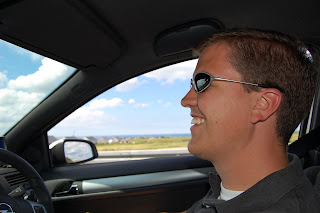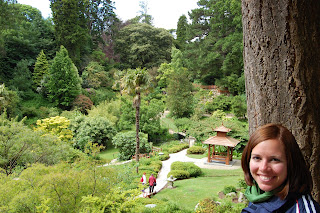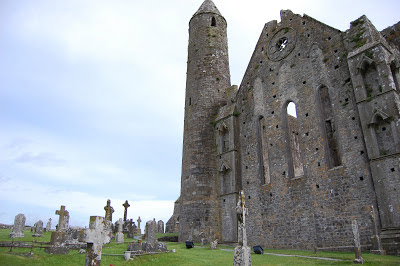Saturday, June 20th - Dublin to Cork
After a terrible night's sleep in our hostel, we packed up our bags and headed for Avis to pick up our second car of the week. We plugged in one of our Irish Cd's (we got 5, mostly full of traditional tunes, and we listened to these throughout the trip, so much so that we were singing along by the end) and set off. We got some great directions from the lady at Avis (when she said "Turn when the road comes to a 'T'", what she apparently meant was "If you don't turn at this intersection, you'll be headed the wrong way down a one-way street". Needless to say, her idea of a 'T' is very different from ours). Luckily, we had paid a little extra for the GPS (named Nora the Navigator by Jenna), which got us back on track pretty quickly.

Our first stop out of Dublin was the Powerscourt Gardens just south of the city. These gardens are outside a one-time palace (now turned into a museum and shops) and is very similar to some of the palatial gardens we've seen elsewhere in Europe. These are famous because 1) they are some of the only gardens like this in Ireland, and 2) they are thought of as the last great gardens built in Europe. They were very nice, containing trees and flowers from all over the world, including a Japanese Garden. As you look at the pictures you may think it looks familiar, as the recent version of The Count of Monte Cristo was filmed here.



We left the gardens and headed southwest through the Wicklow mountains. This area was one of the least green areas we saw in the country, but the landscape was interesting none the less. There were some great views over lakes and rivers, mountains, and thousands of sheep, and as this is a lightly traveled road, we had it mostly to ourselves to enjoy (which was probably good considering how narrow the roads were!).
Our destination after coming through the mountains was the Rock of Cashel, a ruined castle/cathedral near the south-central part of the country, the furthest inland we made it. This was originally built by a Celtic clan several hundred years ago, and traded hands and expanded through the years as it was fought over in tribal wars. The fighting was finally put to a stop when one of the winners got wise and donated it to the Church, where they built a large cathedral and created a large cemetery. High winds and rain in the area caused the castle to fall into disrepair, and as it lost strategic significance when castles became obsolete, it became abandoned and mostly fell apart. It was an interesting place to see - it overlooked some scenic farmland and especially interesting was the cemetery. It was filled with Celtic crosses, which Jenna likes a lot. Apparently, these became popular in Ireland because the circle behind the cross symbolized the sun that most of the local pagans were used to worshiping already, so it was more familiar. Also interesting was the fact that although the castle is in complete ruins, the cemetery still has a few open plots. But you can only be buried there if your great-grandparents are buried there and they signed up for a family plot.


After leaving the Rock of Cashel, we headed south to Cork. We made a quick stop in the port town of Kinsale, just outside Cork, which was suggested for a visit by both our 1,000 Things book and our Rick Steve's guide. Cork is the main city on the south coast where a majority of the immigrants who ended up at Ellis Island departed from. Although most of the ships left from the nearby port of Cobh. Kinsale is supposed to be a nicer town, so we visited there. We actually wouldn't recommend it for a short visit (we were there just an hour or so). There are a few things to see like a large fort and there is supposed to be some good live music later in the evening, but we didn't have time for those, so for us the town wasn't too impressive. After walking around the town and the bay/marina, we headed to our B&B in Blarney, also just outside Cork, where we grabbed dinner and dessert (my first banana split in years!) at a local pub before hitting the hay.
Sunday, June 21st - Cork to Dingle - The Ring of Kerry and Pub Music
On Sunday morning, we enjoyed our first traditional meal at the B&B - Full Irish Breakfast for Aaron which consisted of ham, eggs, sausage, and black pudding (dried pig blood mixed with oatmeal - tastes like sausage but still makes queasy because you know what's in there); A vegetarian omelet for Jenna (cheese on the inside, tomatoes placed nicely on top). On our way out of town, we stopped at Blarney Castle, home of the famous Blarney Stone. We had decided way before hand that we would not be kissing the stone. For one, it is pretty expensive to go in, and the castle itself is not supposed to be too nice. Secondly, if you want a picture of yourself kissing it, you have to pay for the one they take and print - none of your own photography. Lastly, and probably the deciding factor, kissing the stone is one of the biggest tourist attractions in the country, drawing some 500,000 people per year. Since most of those come "in season" from May to September, there are literally thousands of people who put their slobbery mouths on it every day, which is really just gross. Anyway, we'd hoped to just drive by and get a good picture of the castle and say we'd at least seen it. As it turns out, it is hidden away in the woods off from the roads and parking lots, so that was a big bust.
We left town and headed for Killarney, a large town near the Ring of Kerry. Just outside of the town is the Killarney National Park, which from what we hear is a major stop for Americans, but not for other tourists. Not sure what everyone else's problem is, because it was awesome. The park sits on a huge lake and is surrounded by trees and hills. We were able to stop off at several points to see some waterfalls and some amazing views over the countryside. Just how green this area is is hard to believe. The namesake as The Emerald Isle is well deserved. After getting through the park, we started out on the Ring of Kerry.


The Ring of Kerry is a road all along the coast of a peninsula in County Kerry. It is a must do for all tourists making their way through the area. We started out later in the day, around noon, which isn't advisable because of the number of tour buses that clog the very narrow roads in the afternoon. The buses have the right of way, and take up more than half the road, so you have to just pull off to the side. We passed 16 in the first hour, then just another three the rest of the day (they mostly all leave at the same time in the morning, so you hit them in a pack). There were several stops along the Ring, including several 1000 year old forts, some amazing views of sea, mountains, green grass, sheep, cows, and a few beaches. We were surprised by the number of beaches that we found in Ireland - there were 4-5 that we saw - all of which were way too cold to swim in, but provided a nice view none the less. We even stopped for some afternoon tea and scones, which were delicious!



We finished up the Ring by about 6pm, and headed off to our next B&B in Dingle, the main town on the nearby Dingle peninsula. Dingle is famous for its pub music - it has at least 18 different pubs and nearly all of them have live music during the tourist season, and some of the better ones have it year round. Our B&B hostess gave us a suggestion of a good pub for food and music, so we headed off there for what turned out to be one of the best parts of the trip. The food was decent but forgettable, but the two musicians who played were great. They played a lot of traditional songs -probably the more popular ones since we recognized a few from our cd's - but it was a lot of fun. Several locals were here as well (although the majority were tourists) and they were singing along. We definitely got into it, singing along when we could and just taking it in when we couldn't. This was a true highlight of Ireland.
Monday, June 21st - Dingle to Ennis
This was a fairly light day. To start, we enjoyed an amazing breakfast from the B&B - the Milestone House. The Dingle Peninsula is very scenic, much like the Ring of Kerry, so we chatted with the B&B owners for a while about the best things to do. They were amazing, giving us some great advice on places to stop along the way. They also suggested a scenic hike for us to take along some cliffs. If you are ever in the area, we definitely suggest this place!
We started out on a drive around the Peninsula. It was very similar to the Ring of Kerry, only quite a bit shorter and much less crowded. We saw some more amazing views, more forts, the spot where they filmed Far and Away, and thousands of sheep. I'm not sure if this still holds true, but when we were researching we saw that the peninsula is home to about 20,000 people and 500,000 sheep! The highlight of the day was the walk suggested by our hosts. We walked all along the coast through some farmland and along cliffs. We also saw the school house from the film Ryan's Daughter. That would have probably meant something if we'd seen or even heard of that movie, but apparently it was big in the 70s.


We finished driving around the ring by early afternoon, and headed for our next destination - a little further north to Ennis. This was probably one of the big disappointments of the trip. Our books said this was a nice town, and a few places were supposed to have live music, but as we walked around town it was completely dead. One of the two places suggested by both our book and the hostel where we stayed was supposed to have great food and good live music. We walked in at 10:00 (prime time for live bar music) to find 3 guys standing at the bar and not a single other person in the place. We ended up sulking back to the hostel where we spent the evening reading instead.
Thursday, June 22nd - County Clare and back to London
The last day of our trip was pretty light as well. Ennis is the main town in the County Clare, in the east-central part of the country, which is also home to the Cliffs of Moher and the Burren.
We headed first to the Cliffs, which is probably one of the most scenic and famous places in the country. These are huge cliffs and if you've seen pictures of Ireland, you've most likely seen these. Not too much to say - just have a look at the photos, or for a real idea go see them for yourself.


After leaving the cliffs, we drove off to the Burren. This is a barren, rocky land supposedly formed by glaciers. There isn't a ton to see, just some stark landscapes that are very different from the rest of the green country. We drove through, stopped at the one major site (some kind of tomb/burial altar), and took in the views.


There really wasn't much else to do in the area - we didn't have enough time to go to any other site, but it was too early to go to the airport. We ended up making our way to the Dromoland Castle - a super-luxury hotel that was nearby. We had at one time considered staying here and at another castle, but at $700 a night we just couldn't justify the cost. We could justify afternoon tea, though, so we walked around the grounds, gardens, etc (which were very nice-they definitely spend the money well) and had tea in the restaurant in the garden.
After we left the hotel, it was about time to go home, so we headed for the airport, dropped off the car, and made our way back home. Best part of the return trip - a busker (guy playing music for money) was in the train station in London on our way home playing "Oh Danny Boy"!









No comments:
Post a Comment